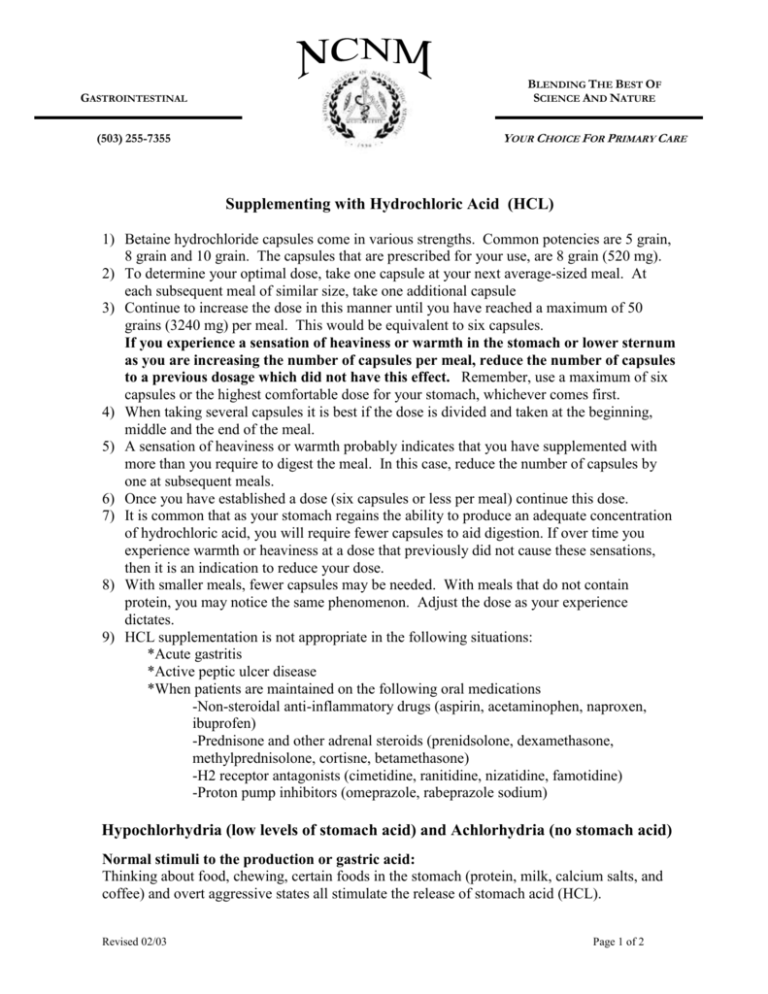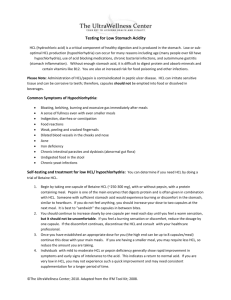Supplementing with HCL
advertisement

GASTROINTESTINAL BLENDING THE BEST OF SCIENCE AND NATURE (503) 255-7355 YOUR CHOICE FOR PRIMARY CARE Supplementing with Hydrochloric Acid (HCL) 1) Betaine hydrochloride capsules come in various strengths. Common potencies are 5 grain, 8 grain and 10 grain. The capsules that are prescribed for your use, are 8 grain (520 mg). 2) To determine your optimal dose, take one capsule at your next average-sized meal. At each subsequent meal of similar size, take one additional capsule 3) Continue to increase the dose in this manner until you have reached a maximum of 50 grains (3240 mg) per meal. This would be equivalent to six capsules. If you experience a sensation of heaviness or warmth in the stomach or lower sternum as you are increasing the number of capsules per meal, reduce the number of capsules to a previous dosage which did not have this effect. Remember, use a maximum of six capsules or the highest comfortable dose for your stomach, whichever comes first. 4) When taking several capsules it is best if the dose is divided and taken at the beginning, middle and the end of the meal. 5) A sensation of heaviness or warmth probably indicates that you have supplemented with more than you require to digest the meal. In this case, reduce the number of capsules by one at subsequent meals. 6) Once you have established a dose (six capsules or less per meal) continue this dose. 7) It is common that as your stomach regains the ability to produce an adequate concentration of hydrochloric acid, you will require fewer capsules to aid digestion. If over time you experience warmth or heaviness at a dose that previously did not cause these sensations, then it is an indication to reduce your dose. 8) With smaller meals, fewer capsules may be needed. With meals that do not contain protein, you may notice the same phenomenon. Adjust the dose as your experience dictates. 9) HCL supplementation is not appropriate in the following situations: *Acute gastritis *Active peptic ulcer disease *When patients are maintained on the following oral medications -Non-steroidal anti-inflammatory drugs (aspirin, acetaminophen, naproxen, ibuprofen) -Prednisone and other adrenal steroids (prenidsolone, dexamethasone, methylprednisolone, cortisne, betamethasone) -H2 receptor antagonists (cimetidine, ranitidine, nizatidine, famotidine) -Proton pump inhibitors (omeprazole, rabeprazole sodium) Hypochlorhydria (low levels of stomach acid) and Achlorhydria (no stomach acid) Normal stimuli to the production or gastric acid: Thinking about food, chewing, certain foods in the stomach (protein, milk, calcium salts, and coffee) and overt aggressive states all stimulate the release of stomach acid (HCL). Revised 02/03 Page 1 of 2 When the acid enters the small intestine it stimulates gall bladder contraction, pancreatic enzyme and bicarbonate production and decreases the appetite. The acid converts pepsin (a stomach enzyme which digests protein) into its active form. Other functions of stomach acid include killing ingested bacteria, yeast and parasites and allowing proper absorption of B12, folic acid, and minerals. Stomach acid levels may also be important in maximizing white blood cell and platelet function. Type of patient that may have hypochlorhydria: Children with asthma, many adults especially after age 50, especially those with diabetes and chronic diseases. What causes hypo and achlorhydia? Diabetes and many other autoimmune diseases, Helicobacter pylori infection, chronic eating of devitalized food, excess dietary fat and sugar, chronic overeating (the stomach has to concentrate the hydrogen ion by 4 million times the level in arterial blood), hypothyroidism, hyproadrenalism, chronic stress, salt-restricted diets and abrupt dietary changes. Type A blood may predispose to hypocholorhydria. Testing for hypo/acholorhydria: Gastrotest measures stomach pH. The gastrotest is a screening test for hypochlorhydria. Heldelburg test measures stomach pH, time required for reacidification and pH after challenge, stomach emptying time and small intestinal pH. Reveals the proper amount of hydrochloric acid needed to normalize stomach acid level. Possible symptoms of hypochlorhyria: Heartburn and indigestion (usually worse when food is in the stomach) gas, bloating, belching; a heavy, long-lasting, full feeling in the stomach; nausea; soft, brittle or peeling nails, hair loss in women, dilated blood vessels on the face; muscle cramps, and chronic bacterial, yeast and parasitic infections relapse after treatment. These patients may have constipation, diarrhea or normal stool. Common diseases associated with hypochlorhydria/achlorhydria: diabetes mellitus, childhood asthma, hypothyroidism, hyperthyroidism, eczema, gallstones, cholecystitis, osteoporosis, rheumatoid arthritis, hives, systemic lupus erythematosis, Sjogren’s disease, adrenal exhaustion, chronic hepatitis, chronic atrophic gastritis, vitiligo and adult acne. Treatment strategies: 1) Chew food thoroughly and take your time. 2) Eat when hungry, rather than when trying to “stuff” emotions. 3) Avoid overeating or excess fluids with meals. 4) Avoid eating while driving a vehicle, on the run, etc. 5) Avoid excessive fat and sugar 6) Take a short walk after eating if possible 7) Avoid constipation 8) Use botanical bitters 10-20 minutes before meals, if prescribed. You can also eat bitter foods. 9) Take ________________ apple cider vinegar mixed in water 10 minutes before meals, if prescribed. 10) Supplement with betaine hydrochloride as described on the cover page, if prescribed. Revised 02/03 Supplementing With HCL Page 2 of 2 References: Sandberg-Lewis, Steven ND. NCNM Faculty, Class notes, 2002 Rev. 07/02 Supplementing with Hydrochloric Acid (HCL), Page 3 of 3







